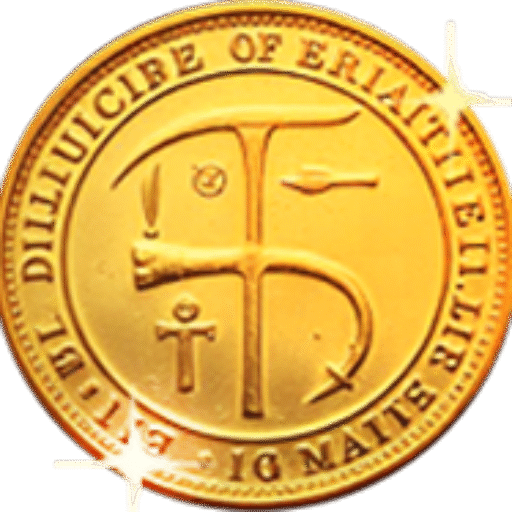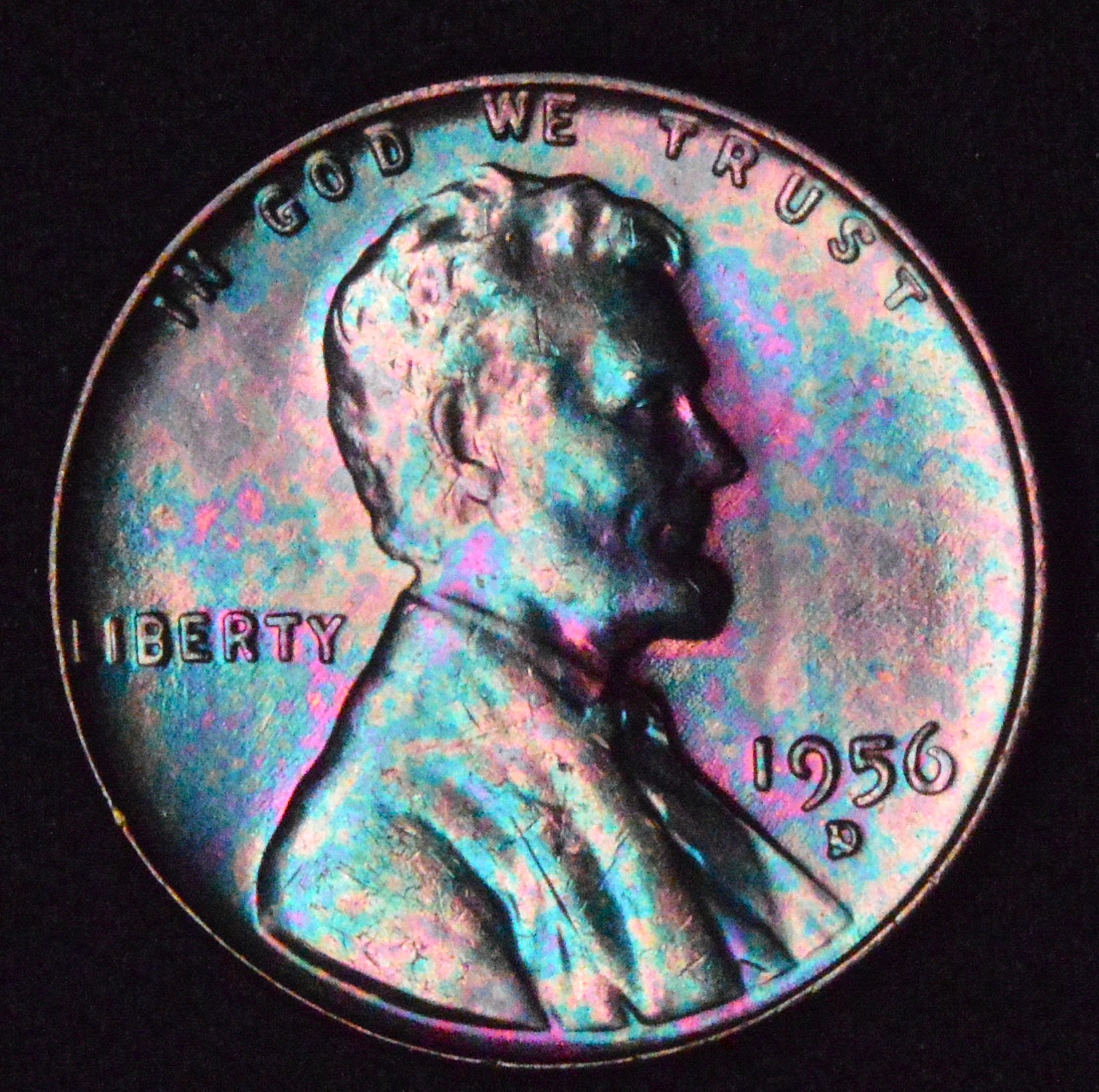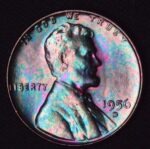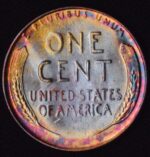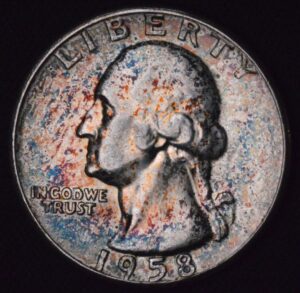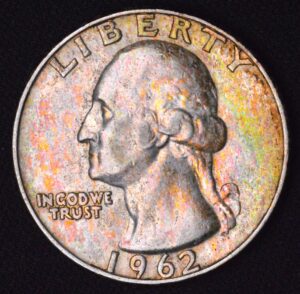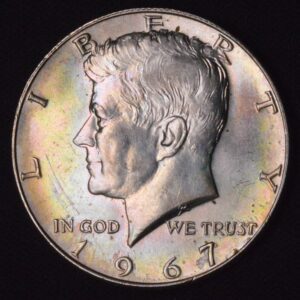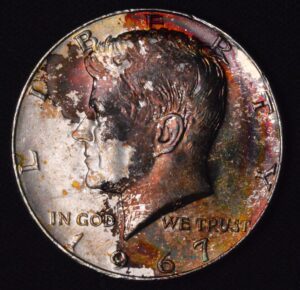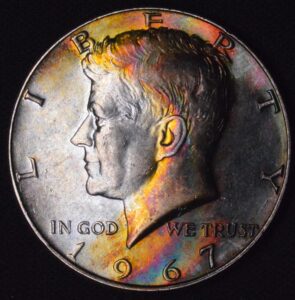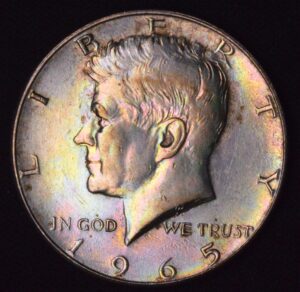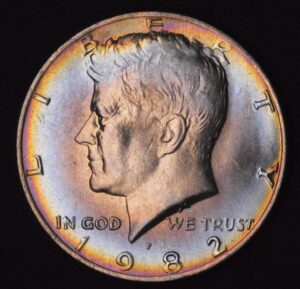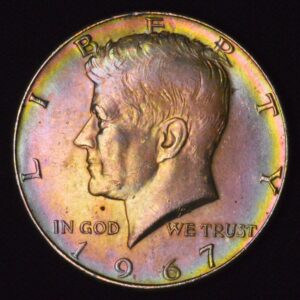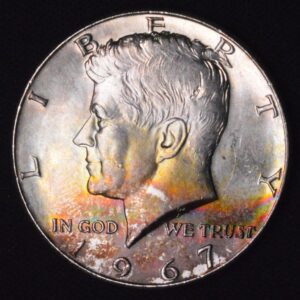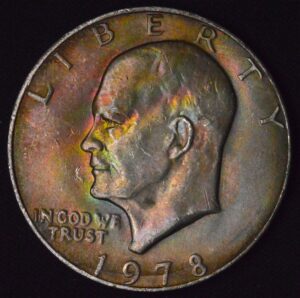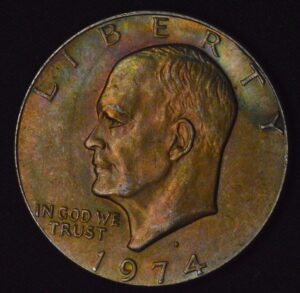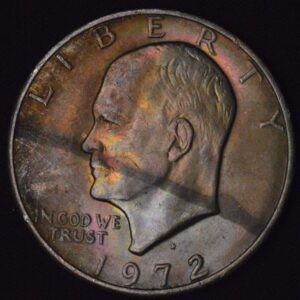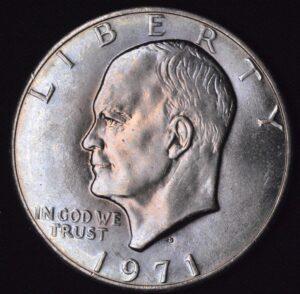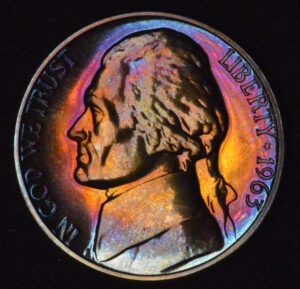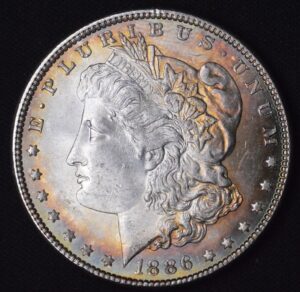Description
The 1956-D Lincoln Cent, minted at the Denver Mint, is a copper-based wheat penny composed of 95% copper and 5% tin and zinc. It has a diameter of 19 millimeters and weighs about 3.11 grams. The Denver Mint produced over 1 billion pennies this year, making it one of the highest mintage years in the wheat cent series. The coin features the classic Lincoln portrait on the obverse, designed by Victor David Brenner, and wheat ears on the reverse symbolizing prosperity.
A 1956-D Lincoln Cent with “monster rainbow toning” describes a coin with exceptionally vivid and broad natural rainbow toning, displaying a range of colors such as blues, purples, oranges, and greens across its surface. This toning develops over many years due to oxidation and interaction with environmental elements, often amplified by conditions inside old coin albums or storage containers. Such toning enhances the coin’s eye appeal and uniqueness, attracting collectors interested in visually striking, naturally toned coins.
Despite the high mintage, a 1956-D Lincoln Cent with monster rainbow toning can command premiums well above standard circulated values, especially in uncirculated condition or better. Collectors prize toning that is natural, vibrant, and evenly distributed, with no detracting spots, making these coins prized additions to collections focusing on color or eye appeal. Certified coins by reputable grading services like NGC or PCGS offer credibility and often sell for more.
Typical 1956-D wheat cents in circulated condition generally sell for less than a dollar, while uncirculated examples range from a few dollars to over $50 depending on grade. However, coins with dramatic monster rainbow toning, especially in high-grade condition (MS65 and above), can fetch hundreds or even more at auction, driven by the demand for rare and beautiful toned coins.
In summary, a 1956-D Lincoln Cent with monster rainbow toning is a highly collectible and visually stunning coin. Its large mintage does not diminish its appeal when the coin displays extraordinary rainbow patina, making it a favored piece among collectors who value natural beauty and historical significance in the wheat penny series.
The 1956-D Lincoln Cent, minted at the Denver Mint, is a copper-based wheat penny composed of 95% copper and 5% tin and zinc. It has a diameter of 19 millimeters and weighs about 3.11 grams. The Denver Mint produced over 1 billion pennies this year, making it one of the highest mintage years in the wheat cent series. The coin features the classic Lincoln portrait on the obverse, designed by Victor David Brenner, and wheat ears on the reverse symbolizing prosperity.
A 1956-D Lincoln Cent with “monster rainbow toning” describes a coin with exceptionally vivid and broad natural rainbow toning, displaying a range of colors such as blues, purples, oranges, and greens across its surface. This toning develops over many years due to oxidation and interaction with environmental elements, often amplified by conditions inside old coin albums or storage containers. Such toning enhances the coin’s eye appeal and uniqueness, attracting collectors interested in visually striking, naturally toned coins.
Despite the high mintage, a 1956-D Lincoln Cent with monster rainbow toning can command premiums well above standard circulated values, especially in uncirculated condition or better. Collectors prize toning that is natural, vibrant, and evenly distributed, with no detracting spots, making these coins prized additions to collections focusing on color or eye appeal. Certified coins by reputable grading services like NGC or PCGS offer credibility and often sell for more.
Typical 1956-D wheat cents in circulated condition generally sell for less than a dollar, while uncirculated examples range from a few dollars to over $50 depending on grade. However, coins with dramatic monster rainbow toning, especially in high-grade condition (MS65 and above), can fetch hundreds or even more at auction, driven by the demand for rare and beautiful toned coins.
In summary, a 1956-D Lincoln Cent with monster rainbow toning is a highly collectible and visually stunning coin. Its large mintage does not diminish its appeal when the coin displays extraordinary rainbow patina, making it a favored piece among collectors who value natural beauty and historical significance in the wheat penny series.
The 1956-D Lincoln Cent, minted at the Denver Mint, is a copper-based wheat penny composed of 95% copper and 5% tin and zinc. It has a diameter of 19 millimeters and weighs about 3.11 grams. The Denver Mint produced over 1 billion pennies this year, making it one of the highest mintage years in the wheat cent series. The coin features the classic Lincoln portrait on the obverse, designed by Victor David Brenner, and wheat ears on the reverse symbolizing prosperity.
A 1956-D Lincoln Cent with “monster rainbow toning” describes a coin with exceptionally vivid and broad natural rainbow toning, displaying a range of colors such as blues, purples, oranges, and greens across its surface. This toning develops over many years due to oxidation and interaction with environmental elements, often amplified by conditions inside old coin albums or storage containers. Such toning enhances the coin’s eye appeal and uniqueness, attracting collectors interested in visually striking, naturally toned coins.
Despite the high mintage, a 1956-D Lincoln Cent with monster rainbow toning can command premiums well above standard circulated values, especially in uncirculated condition or better. Collectors prize toning that is natural, vibrant, and evenly distributed, with no detracting spots, making these coins prized additions to collections focusing on color or eye appeal. Certified coins by reputable grading services like NGC or PCGS offer credibility and often sell for more.
Typical 1956-D wheat cents in circulated condition generally sell for less than a dollar, while uncirculated examples range from a few dollars to over $50 depending on grade. However, coins with dramatic monster rainbow toning, especially in high-grade condition (MS65 and above), can fetch hundreds or even more at auction, driven by the demand for rare and beautiful toned coins.
In summary, a 1956-D Lincoln Cent with monster rainbow toning is a highly collectible and visually stunning coin. Its large mintage does not diminish its appeal when the coin displays extraordinary rainbow patina, making it a favored piece among collectors who value natural beauty and historical significance in the wheat penny series.
CUSTOMER FEEDBACK

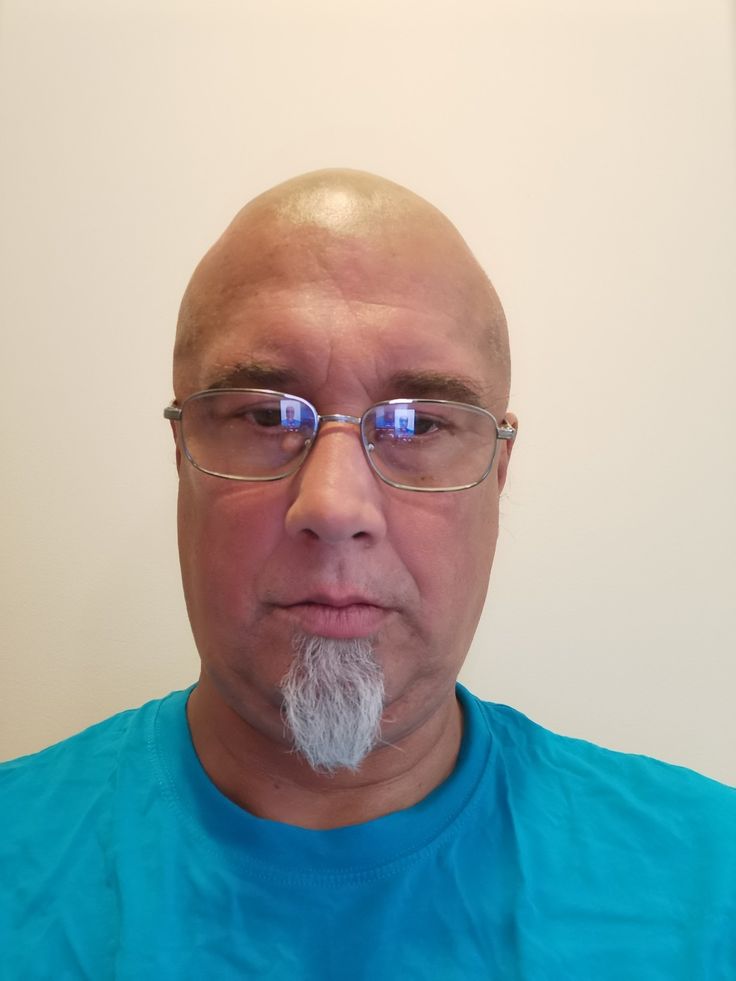


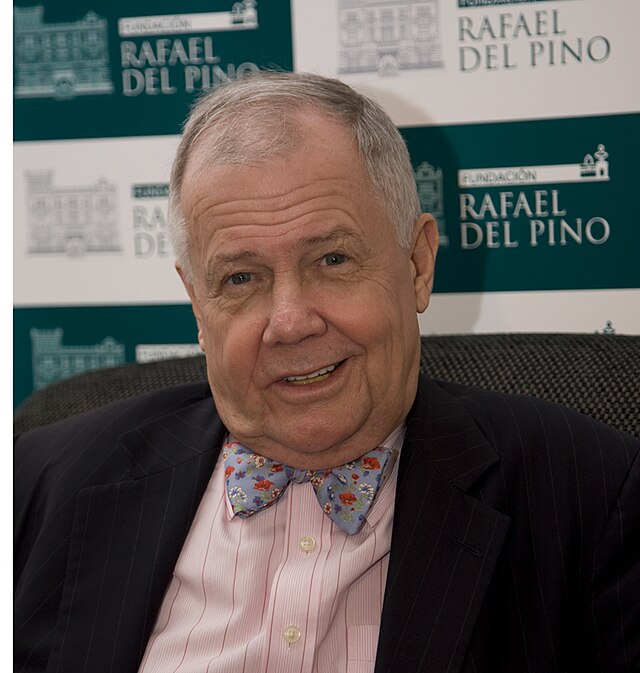


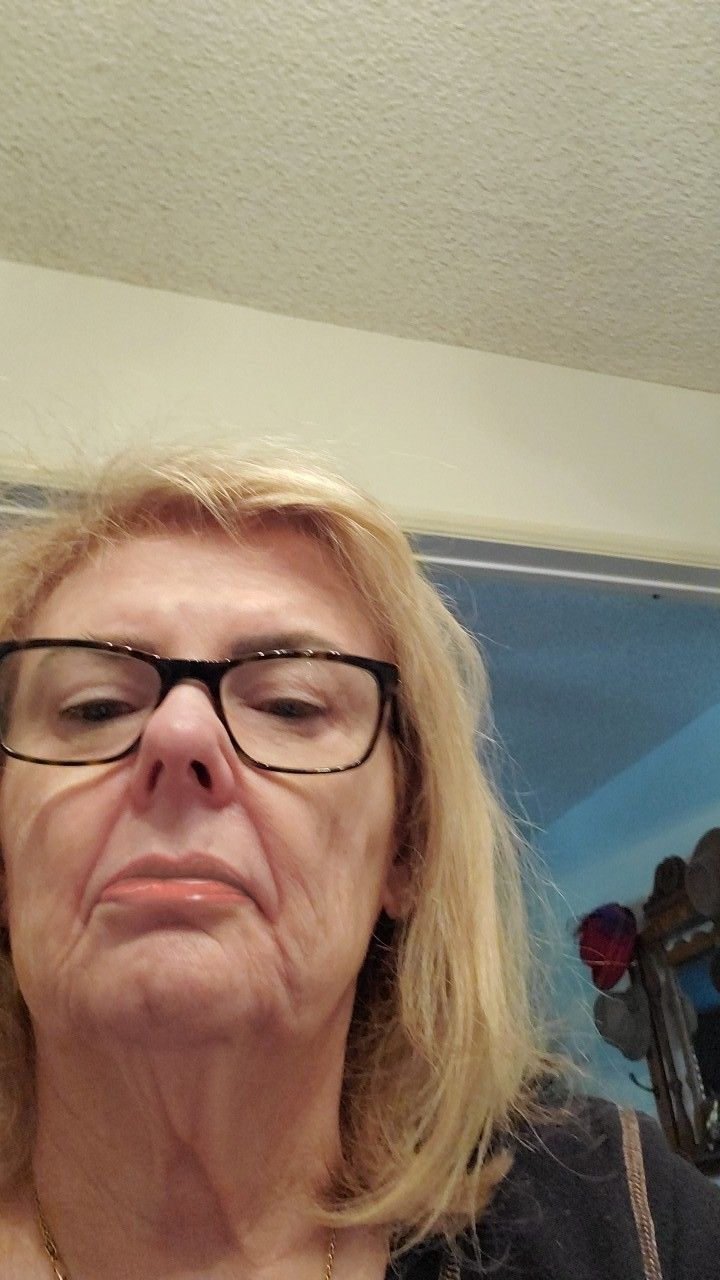
Related Products & Newly Released!




SHIPPING POLICY
Your order is shipped from the United States with USPS tracking within one business day.
14 Day Return Policy
You can return your item back within
14 days of the purchase

Secure payments
Your payments are 100% secure and are processed through Square or PayPal on a protected security network.
SHIPPING POLICY
FREE International and Domestic (United States) shipping. Your order is shipped with USPS tracking 24 hours after you order.
14 Day Return Policy
You can return your item back within
14 days of the purchase

Secure payments
Your payments are 100% secure and are processed through Square or PayPal on a protected security network.
RESOURCES
support
Get Fresh Articles!
Sign up now to receive our articles for the latest insights and promotions!
RESOURCES
support
Get Fresh Articles!
Signup our newsletter to get update insight or promotions.

